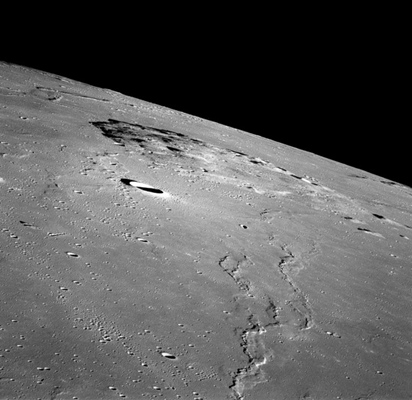February 15, 2015
Volcanic Rump
Originally published February 15, 2004
Image Credit: Apollo 15 (AS15-97-13252) |
|
Volcanic Rump We think of the Apollo missions as being near equatorial - and the landing sites were - but the sinusoidal orbit of the Command Modules took them as much as 25 degrees from the equator. And by pointing a handheld Hasselblad toward the horizon, the lone astronaut in the CM could image as far as 40 degrees north, as in this near-profile view of Rumker. This ~60 km wide and few hundred meters high mound can be considered as the largest lunar dome. It is a complex structure with a broad, low-angle rise that hosts 6 to 10 smaller, mostly steeper sided domes. Lunar Orbiter pictures show that at least two of these small domes have summit pit craters. Rumker has an off-center flat interior, so that the overall structure appears like a broad ring. It is a bizarre feature that clearly has volcanic features, but its also possible that some of its elevation results from uplift. Two other things to note: The wrinkle ridges at the lower right also show a two component structure. They commonly have a relatively sharp crestal ridge that rides on a broader, gentler base. Second, did you notice the line of clustered small craters running diagonally across the bottom left? They are secondary impact craters, but the source crater isn't obvious. Related Links: Yesterday's LPOD: Happy Valentine Dome Day! Tomorrow's LPOD: The Image that Launched LPOD |
|
Author & Editor: |
COMMENTS?
Register, Log in, and join in the comments.




